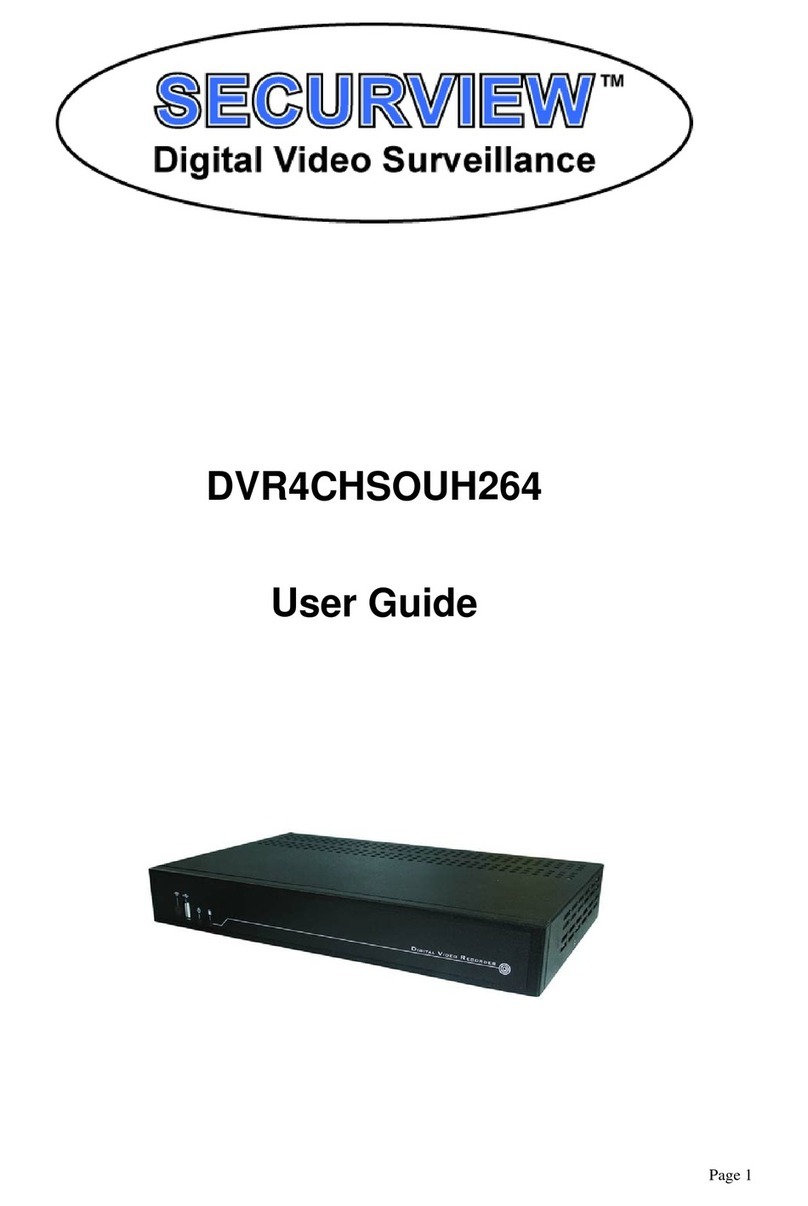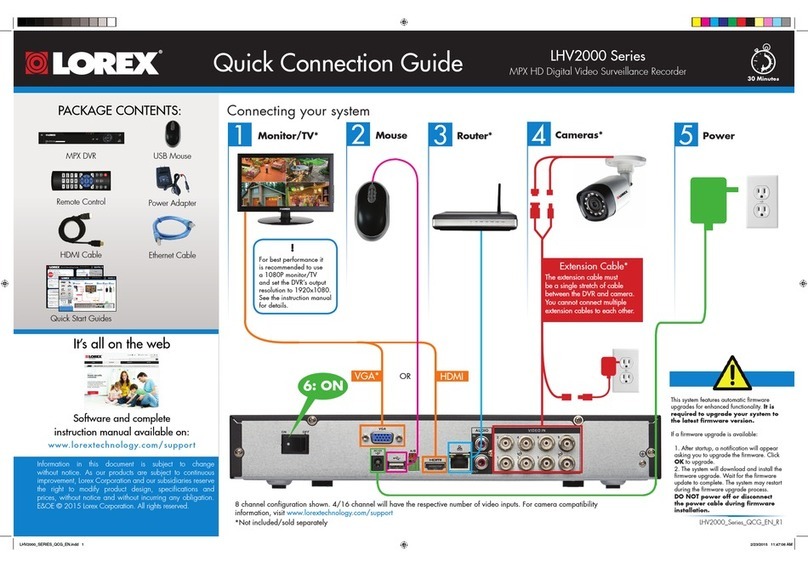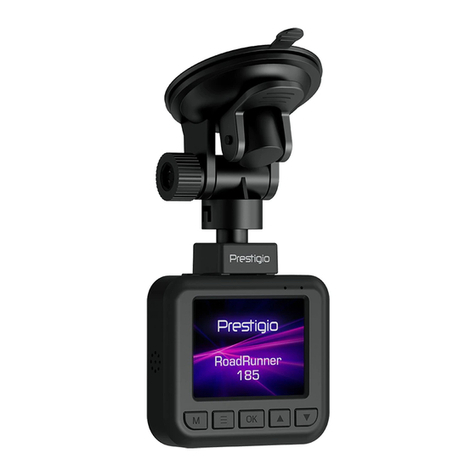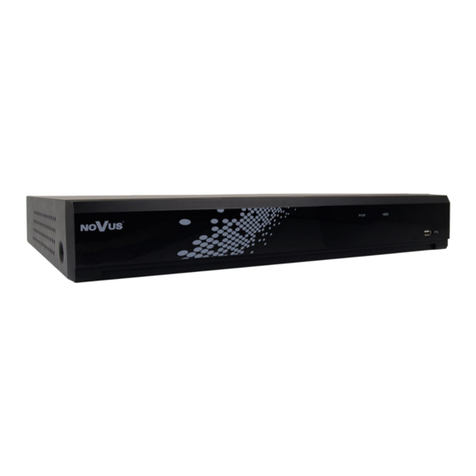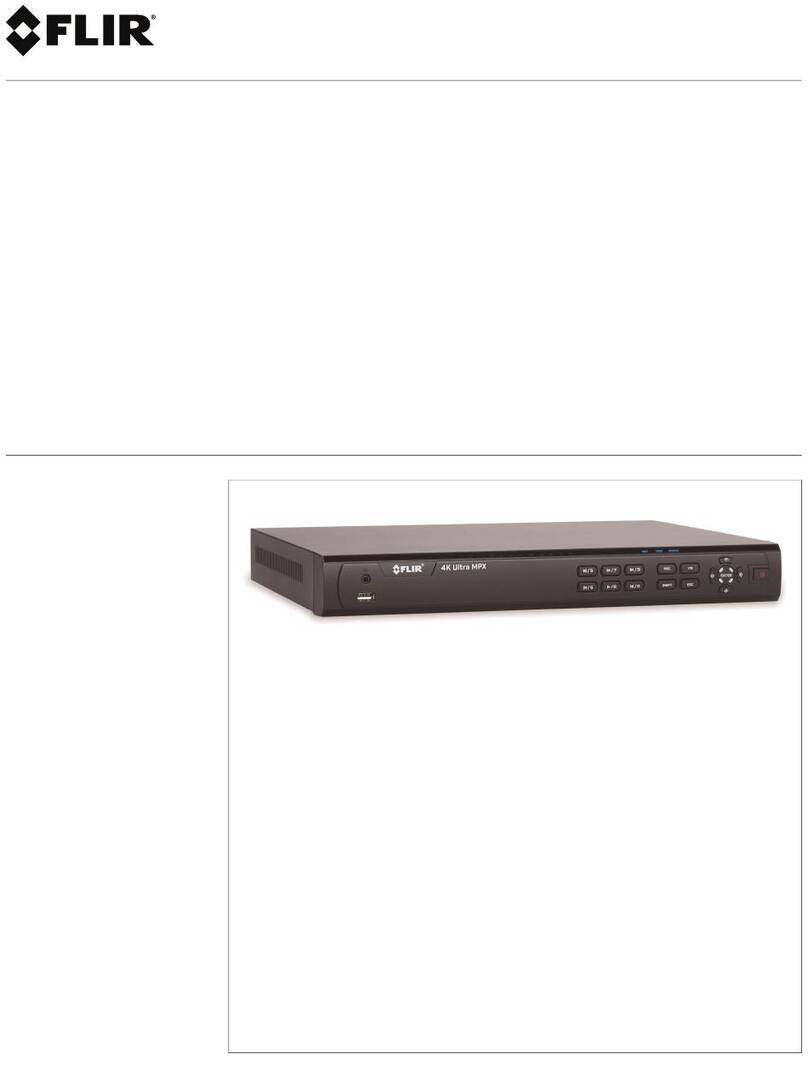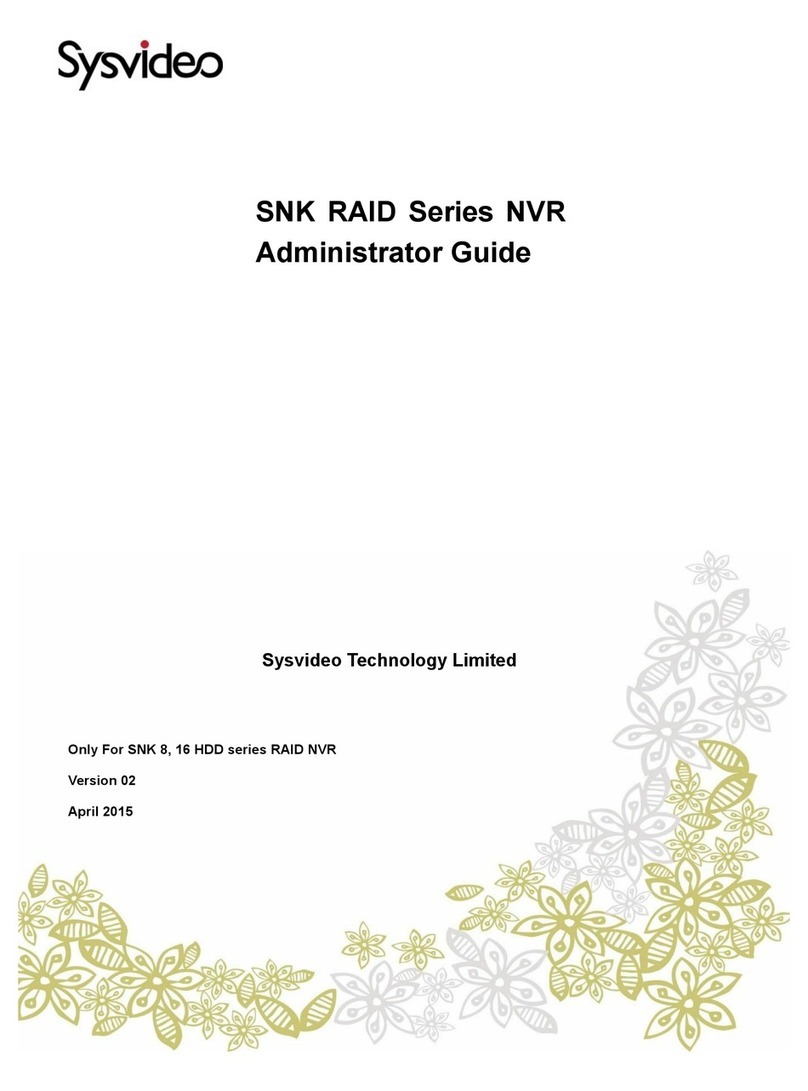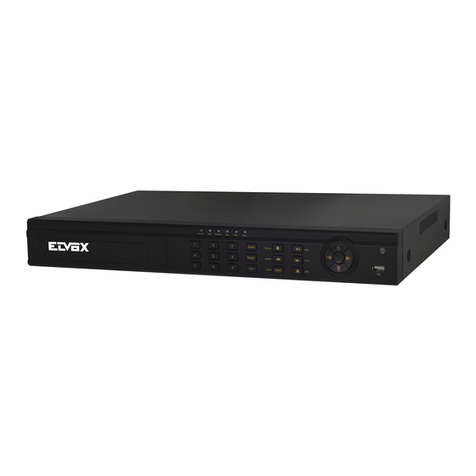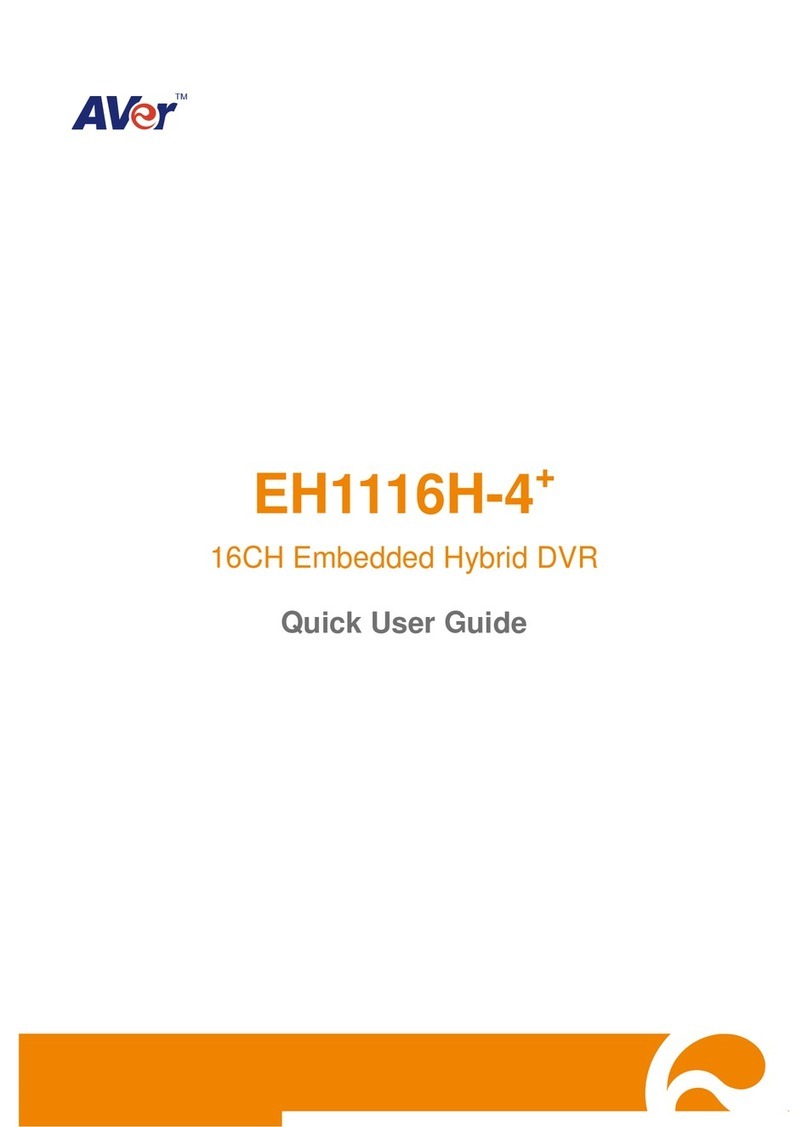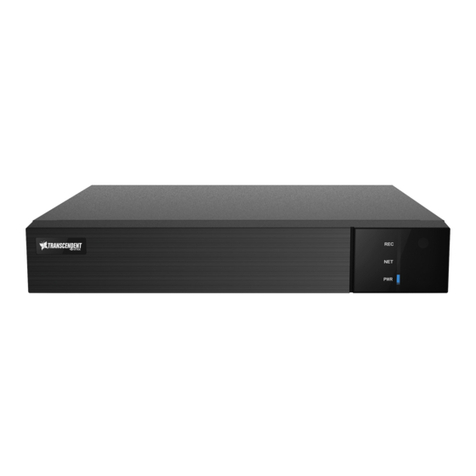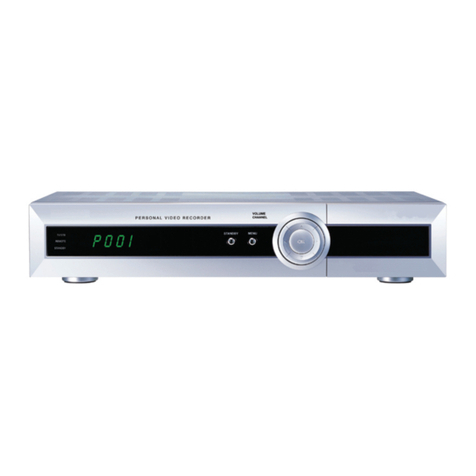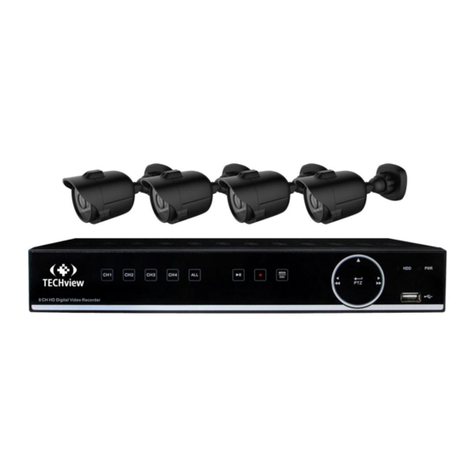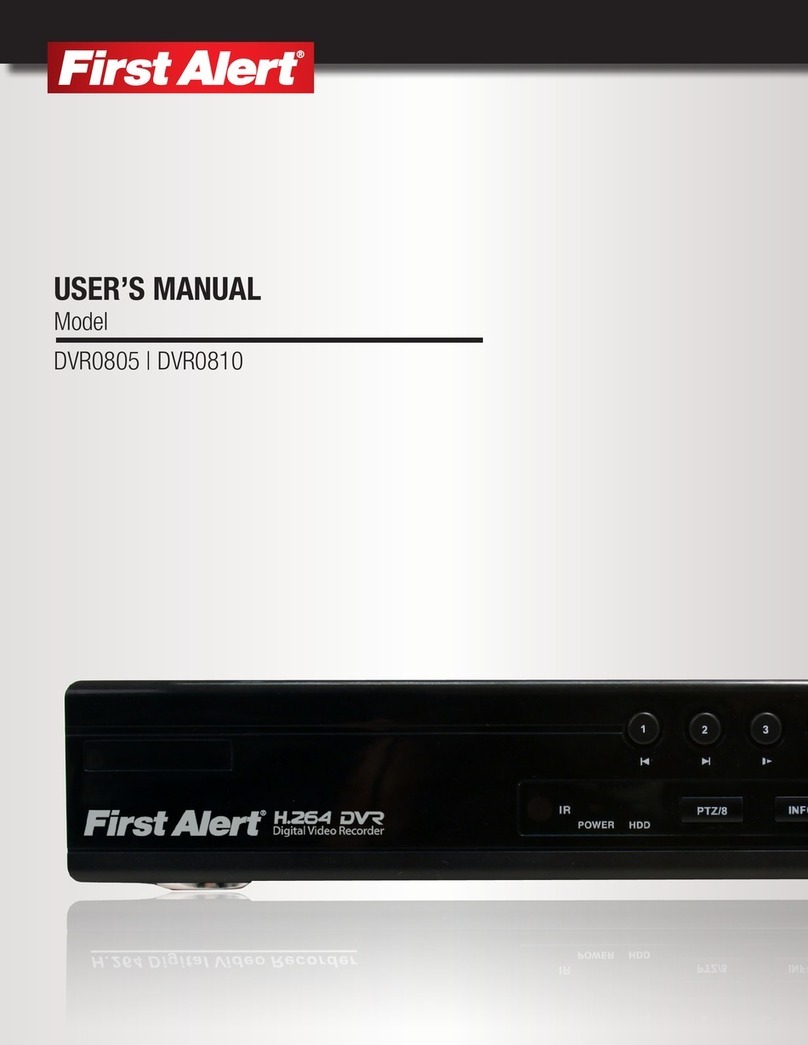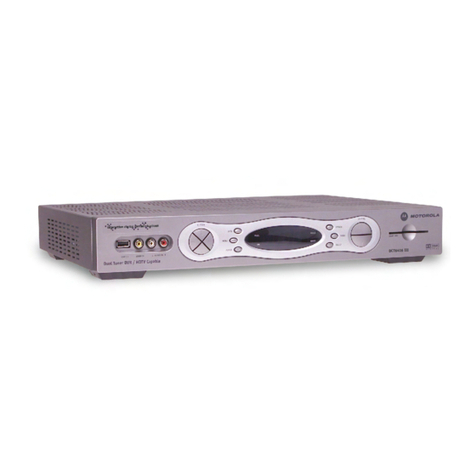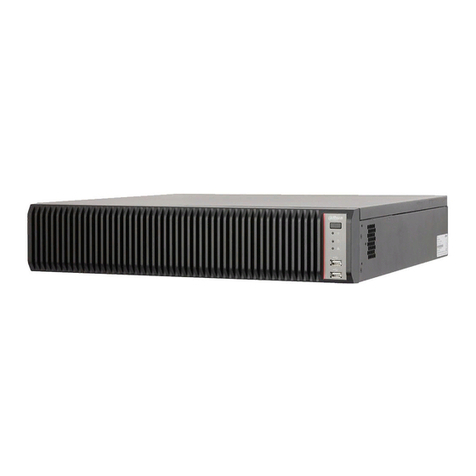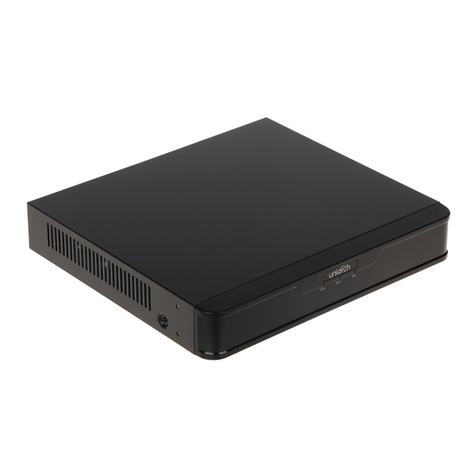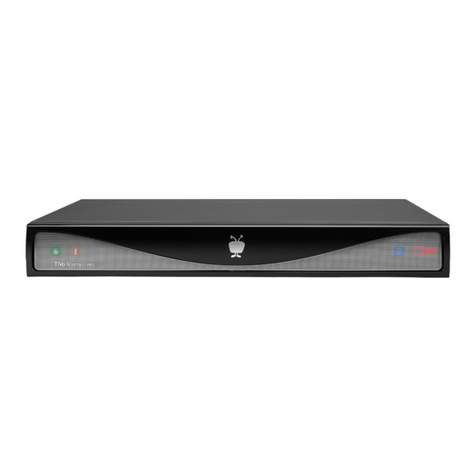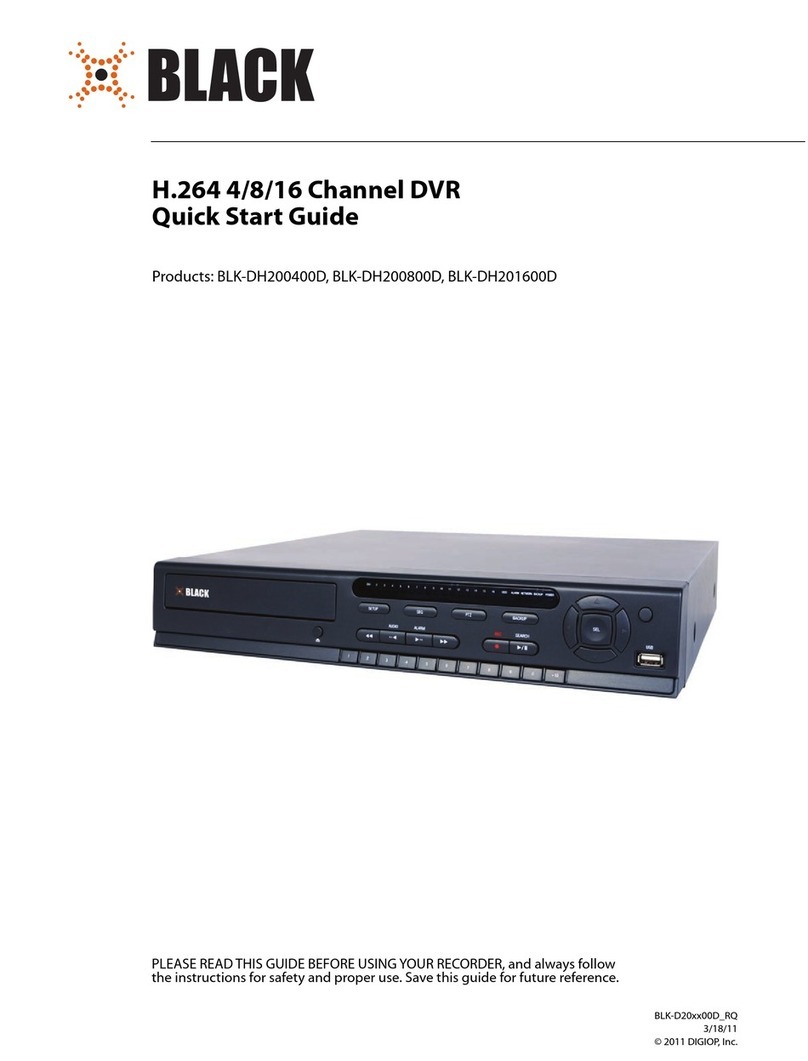SecurView DVRSVIEWxV4 User manual

MODEL: DVRSVIEWxV4
Professional Surveillance System
Digital Video Recorder
‘QUICK INSTALLATION GUIDE’
DVR
-Advanced H.264 Video Compression Technology
-Multiplex Operation
-Real-time recording
-Long Recording Duration
-Intelligent Video Motion Detection Recording
-Remote Network Surveillance & Backup Functions
-Easy to operate with USB Mouse or IR Remote.
-System Auto recovery after power loss (blackout)
N517
www.securview.com.au
V3.2 180214

1

2
DVRSVIEWxV4 Package Contents (Before installation, please ensure you have all the parts listed below).
1 x Digital Video Recorder
● Advanced H.264 Video Compression Technology for High Quality Images
● Easy to Operate
● Can be Connected to a PC Network for Remote Viewing & Backup (Software on Disc)
1 x HDMI Connection Cable
● Connect the DVR to a HDMI ready TV or Monitor
1 x USB Mouse
● To operate the DVR
1 x IR Remote Control with batteries
● To operate the DVR

3
Installation
Before installing this unit, please read through the following points:
•Do not place cords from the AC adapter where they can be pinched or stepped on.
•Leave at least 50mm of space between the DVR and other objects to allow air circulation.
•Do not expose the DVR or Cameras to excessive heat, cold, or moisture.
•Never immerse any component in water, and do not spray cleaners of solvents on the unit. Unplug
units before cleaning. When cleaning, use a damp, lint-free cloth only.
•Do not place heavy objects on cords, or cover cords with rugs or carpet.
•Service should be handled only by qualified technicians.
Rear Panel
1 “Ground” Grounding Point
2 “240V” Connect to 240V power.
3 “POWER” Switch on/off to supply power to the device.
4 “Fan” DVR Cooling
7 “Loop Outputs” Some Models will have Loop outputs
8 “VIDEO INPUT” BNC Analogue Video connection for 8 – 32 cameras.
9 “VIDEO OUTPUT” BNC Analogue Video Output.
10 “Matrix output” Matrix video output
11 “AUDIO OUT” Audio Output.
14 “ALARM INPUT”
Alarm input panel, see User Manual or Included CD for more
information.
15 “VGA” Connect to monitor using VGA cable. (Not Supplied)
16 “HDMI” Connect to Digital Monitor with supplied HDMI cable.
17 “RS232”RS323 connector for optional terminal configuration.
19 “USB PORT” Connect USB Mouse.
20 “LAN PORT” Connect to Network/Internet for remote monitoring.

4
Front Panel
0 “NUMERALS”
Buttons marked with numbers can be used to enter numeric data when
in numeric text entry mode (See “SHIFT”)
1 “PLAYBACK” Playback controls used when viewing recorded footage.
2 “CAMERA LIGHTS” Displays recording cameras. (Unit limited to four maximum)
3 “STATUS LIGHTS” Shows device is powered/reading HDD/connected to network.
4 “REC” Manually start/stop recording.
5 “DIRECTION CONTROLS”
Used to select and enter options in menus.
6 “ESC”Go to previous menu/cancel current operation.
7 “POWER” Hold for three seconds to power on/off device.
8 “FN” Various auxiliary functions.
9 “SHIFT” Switch between text entry modes. (Numerals, English, Capitals, etc.)
10 “USB PORT” Connect USB storage device or USB Mouse.
0
3
2
10
4 1
7
8 5
6
9

5
Main Screen
Once booted, you will be presented with the screen below (camera may only be black if not yet set up).
Each camera view will have one or more symbols from below:
1
Currently Recording
3
Video Loss
2
Motion Detected
4
Camera Lock
System Menu
•Right Clicking will bring up the System Login screen and the onscreen keyboard.
•Once Logged In, right clicking again will bring up a menu.
•Selecting “MAIN MENU” will show the system menu.
•Right click or press the ESC button to return to previous menus, click on the icon to enter menus.
Channel View Menu
Moving the mouse to the top of each channel in the live view screen will show a menu.
From left to right:
•Playback: Show, in live view, the past few minutes of footage.
•Search tag: Turn on search tag.
•Save: Save the currently displayed file to USB device.
•Camera Source:Change the IP Device for this feed.
•Close: Close the channel view menu.
Default:
The default username is admin, the password is also admin.
On the DVR physically, you may also use username of 888888, and the password 888888.
(Users can alter the password later. Please refer to the Advanced set up guide CD)

6
Set the Time and Date
When using your DVR for the first time, you will have to set the SYSTEM TIME.
•Right clicking anywhere on the screen will bring up the password menu.
Use the mouse to enter the DVR admin password with the on-screen keypad.
•Then Right click to open the menu and select “MAIN MENU”.
•Select “SETTING”
•Select “GENERAL”
•Set System Time, Date Format and DST (Daylight Saving Time) for your region.
•Click Save before clicking OK
Important:
If you change the date or time on your DVR after the recording function is activated, the recorded data may be
deleted. After setting the date and time, it’s recommended to clear all HDD data, and start recording again.

7
To Set Up Recording Rates
Right click to open the menu and select MAIN MENU, then select SETTINGS followed by ENCODE.
Here you may can set individual encoding options for Regular, Motion Detect and Alarm Recording.
While any of the cameras may be set higher, please be aware that it will reduce the total recording time
to less than 2 weeks. We recommend:
CIF cameras: Set to H.264 with a 352x288 resolution, 10fps, Bit Rate CBR of 320kbps.
D1 cameras: Set to H.264 with a 704x576 resolution, 10fps, Bit Rate CBR of 768kbps.
Important: The EXTRA STREAM MUST be enabled if you wish to remote access the DVR system. We
recommend that it is always set to CIF resolution, 10fps, Bit Rate CBR of 320kbps
To Begin Recording
Once you have successfully set up the cameras, exit the Menu by right clicking or pressing the CLOSE
button. By default, the DVR will begin recording when it is properly connected to the cameras and has an
installed HDD. If it is recording, the recording icon “ ”will be displayed on screen.
Automatic Overwriting:
When the system is in full, the oldest recorded data will be overwritten automatically. This DVR
System is set to Overwrite by factory default but can be changed in the “GENERAL” Menu.
Record Times:
The DVRSVIEWxV4 system is capable of storing up to 2 week of recorded footage based on 2Tb
of storage and 16 Cameras set to D1 @ 10fps and CBR @ 768kb/s

8
To Set Camera Colour Settings
1. Right click to open the menu and select COLOR SETTINGS
2. Here you can adjust the IP Cameras Colour, Gain, BLC, WDR and Day/Night.
Please ensure that Day/Night is always set to Auto. Failing to do so could mean the
Cameras are unable to see at night, or become stuck in black/white during the day.

9
Motion Detection
Should you wish to use Motion detect recording, it can be set per camera, per time period and
to detect in certain portions of the screen.
•Right click to open the menu and select “MAIN MENU”.
•Select “SETTING”
•Select “DETECT”
•Select ‘Motion Detect’ from Event Type
•Select channel from Channel drop down
•Check the Enable box
•Ensure Record Channel is checked, and a Region has been selected.
•Click Save.
More Settings:
Latch
Time to wait after motion is detected, before checking for motion again.
Region
Select
Select region of feed within which motion detection will occur.
Click and drag with the mouse to arm/disarm areas of the feed.
Motion detected in red areas will cause recording, motion will not be detected in
grey areas. Press “ENTER” to save.
Sensitivity
Select from 1 to 6 the sensitivity of the recording, 6 being the most sensitive to
movement.
•Right click to open the menu and select “MAIN MENU”.
•Select “SETTING”
•Select “SCHEDULE”
•Select a channel.
•Choose a period and set the time options to the period you wish to motion record, bearing in
mind system uses 24 hour time.
•Check MD for this period.
•Click OK to save.

10
How to Playback Video Footage on your DVR
1. Right click anywhere on the screen to bring up the menu and log on. Use the mouse to enter the
DVRs admin password “888888” with the on-screen keypad.
2. Once logged in you can left click to open the menu and select SEARCH.
3. You will now see the DVR search screen. On the right hand side there is a calendar in which you can
select the month and day you wish to playback.Any date that is highlighted blue has video available
to playback.
4. Once you have selected the day, you can choose which cameras you wish to playback, and the
mode in which they will be displayed (1ch, 4ch, 8ch, 16ch at a time).
5. Finally you can select the time from the time bar at the bottom of the screen. You will notice that the
hours are listed from 00:00 to 24:00. Simply clicking on the bar will display the video footage from
that time. A green bar will indicate that there is video available at that time.

11
How to Backup Video Footage on your DVR
1. Right click anywhere on the screen to bring up the menu and log on. Use the mouse to enter the
DVRs admin password “888888” with the on-screen keypad.
2. Once logged in, you can now left click to open the menu, select MAIN MENU then BACKUP.
3. You will now see the DVR Backup Devices where you can choose the device you wish to backup to.
Choose your device and click BACKUP to continue.
4. You will see the DVR Backup screen where you can choose the Camera Channel, followed by the
Start and End times for the section of video you wish to backup. Click ADD to save your selection,
and repeat process for any addition video footage you wish to back up.
5. Once you have selected all the video to be backed up, press Start to begin the transfer process.
In order to backup Video Footage from your DVR you will first require a USB Stick or USB Hard Drive (we strongly
recommend having a FAT32 file system).

12
Using a PC to find available IP Addresses
Before setting up your DVR you will first need to find it an IP address, along with all your IP Cameras.
This process is to help you find what IPAddresses are currently in use on your computer network, and in
turn which ones are still available. If you are not connecting the DVR to a computer network (or internet
connection) then any default IP address range may be used like192.168.0.100 to 192.168.0.130.
We recommend 192.168.0.100
Before starting you must first have a copy of the “Free IP Scanner” Tool which can be downloaded
here: http://downloads.rhinoco.com.au/dvr/Free_IP_Scanner.zip
1. Open the Free IP Scanner Tool (if it asks for registration just press skip as it is free to use).
2. Begin the scan by clicking on
3. The “Free IP Scanner” will automatically detect all IPAddresses on your Computer network and
display which ones are in use by listing with a Green tick beside them.
Those which have a red cross beside them are not currently in use and may be available.
Note: Even though lower numbered address may be free (such as “?.?.?.8”) we recommend using
higher number which are unlikely to be used in the immediate future such as “?.?.?.100” onwards.
4. If you wish to Export the list, you can do this by going to FILE and choosing EXPORT. It can then be
saved as text file and even emailed.

13
Set Up the DVRs Networking
Right click to open the menu and select MAIN MENU, then select SETTINGS followed by NETWORK.
The device comes pre-configured to DHCP (which means it will automatically receive an IP
Address). If you wish to manually give it an IP Address, un-tick DHCP and then enter the IP
Address, Subnet mask, and Gateway.
In this example we have used 192.168.0.100

14
Configure your DVR for Remote Access
To be able to set your DVR up for Remote Access, you will first require:
An ADSL connection of 512/512 minimum (ADSL2 recommended).
An ADSL Modem which supports Port Forwarding (such as Sapido, D-link or Netgear).
An “External static IP address” from your Internet Service Provider.
An “Internal Static IP address” from your Modem.
A network cable between your DVR and your Modem.
A windows PC on your network to configure your modem.
Once you have these you can proceed to set up the Remote Access by:
1. Give your DVR the internal IPAddress.
2. On the DVR change port 80 to port 88.
3. Ping the DVR from a local computer to ensure it is reachable on your network.
4. Port forward ports 88, 37777, 37778, 554 in the modem, to the “Internal IP address” of the DVR.
5. You should then be able to test the connection to the DVR over the internet from a different
internet connection (or mobile on 3G).
Test your Remote Access by connecting to the DVR:
When you are in the same building as the DVR you will be able to connect via WIFI and use the “Internal
IP address” of the DVR. However when you are not where the DVR is and wish to connect via the
internet or 3G, you would use the “External static IP address” given to you by your Internet Service
Provider.
Port forwarding support:
There are many different brands and models of ADSL Modems which makes them difficult to set up, this
is why we must recommend an IT professional. Some manufacturers offer guides on their websites or
alternatively we can recommend Third-party assistance on configuring port forwarding from sites such
as: www.portforward.com
When using more than one DVR on a site:
Should you have more than one DVR on site it may be necessary to set the second machine to a
different set of ports. For example set DVR 1 to port 88 and then DVR 2 to port 89.
Important: Before Setting up remote access for your DVR, you will need a good understanding of computer
networks. If you do not, please seek the assistance of a qualified I.T. professional.

15
Set up DDNS on your DVRSVIEWxV4
DDNS is a service that will track your numeric IP address and allow you to attach an alphanumeric
address. So for example, instead of using “123.123.123.123” (the Google address) you would use
“google.com”.
Why use DDNS?
Remembering a numeric IP address can be complicated, where an alphanumeric address is easy to
remember. The other main advantage for DDNS is If you have a dynamic ip address, (where your
address can change monthly) the DDNS service will track and update with your new IP address
automatically. So no matter what your numeric ip address is, your alphanumeric address will work. There
are free and paid services available, however a free DDNS service has been built in to these DVRs. This
tutorial will go over how to set up your DVR to use the free DDNS service.
How to enable your DDNS?
In order to set up DDNS on your DVRSVIEWxV4, you will need to enable the DDNS service in the
Network settings. MENU > SETTING > NETWORK > NETWORK SETTING > DDNS (double click).
Set DDNS Type to "Private DDNS" and Tick ENABLE
SERVER IP to www.dahuaddns.com
DOMAIN MODE to "Default Domain"
DOMAIN NAME is your unique <MAC address>.dahuaddns.com
Username is left Empty
Now when trying to connect externally you would now use the CURRENT HOST ADDRESS
instead of the internal IP address.
e.g. <MAC address>.dahuaddns.com
(Note: This is also dependent on Port forwarding being set up in your ADSL modem. Please use the
default unique ID not <MAC address> as it is just an example).

16
How to enable ActiveX Controls
We can only recommend using ActiveX Internet Explorer 5.5 or above, and strongly recommend the use
of IE9 as unfortunately IE10 is not compatible.
To enable ActiveX controls go to: Tools > Internet Options > Security > Custom Level > Then once in
the Security Settings, enable all ActiveX related options. Please see the settings below:
Important: Before Setting up remote access for your DVR, you will need a good understanding
of computer networks. If you do not, please seek the assistance of a qualified I.T. professional.

17
DMSS Mobile App
App available for Android, iOS, Blackberry, Symbian, Windows Mobile and Windows 7 mobile
From your compatible Smartphone, access the App Marketplace and download the free App. This may
also be listed as:
iDMSS lite for Apple iOS
gDMSS lite for Android
DMSS lite for others
Configuration:
1. Go to “MENU” then “Device manager”and select “ADD” .
2. Set “Register Mode” to “IP/DOMAIN”
3. Enter in your devices NAME, IP Address or DDNS and TCP Port (default is 37777).
4. Enter your Username / Password and the set Live Preview and Playback to “Extra”.
5. Select “SAVE” in the top right corner or “Start Live Preview” to save and connect.
6. You be returned to your Live View screen where your camera feed will now be displayed.
7. In the future, you can connect to your system directly from the main screen by tapping the
“DEVICE LIST” then ticking your DVR and selecting the “Start Live Preview” to connect.

18
Troubleshooting
Please refer to the FAQ table below for easy troubleshooting. The table below describes some
typical problems and their solutions. Please consult these guides before contacting your DVR
dealer.
PROBLEM
SOLUTION
No power - Check power cord connection.
- Confirm that there is power from the outlet.
- Ensure that the power is connected to the DVR
Motion Detection not working - Ensure that motion detection is enabled for that
channel in the “DETECT” menu.
No live video
- Check the cameras cable and connections.
- Check the monitors cable and connections.
- Ensure you are not in playback mode.
Turn the DVR off and power on while holding the
SHIFT button.
No video over the network with web
browser or mobile - Make sure that Extra Stream is enabled for each
camera on the DVR.
No recorded video - Check if the HDD is installed and connected properly.
Can’t detect your USB flash drive - Use another USB flash drive to test.
- Ensure it is formatted to FAT32.
- Check Appendix B of User manual (on CD).
Can’t view the DVR images over the
network with web browser
- Ensure you have installed the ActiveX
- Check Section 8 of User manual (on CD).
This guide is intended as a Quick Set Up and Basic use manual only, please refer to the
user manual on the included CD for all other details.

19
Limited Warranty
Cornick Pty Ltd (Seller) warrants its products to be in conformance with its own plans and specifications and to be free from
defects in materials and workmanship under normal use and service for twelve months from the date of original purchase.
Sellers obligation shall be limited to repairing or replacing, at its option, free of charge for materials or labor, any part which is
proved not in compliance with Sellers specifications or proves defective in materials or workmanship under normal use and
service. Seller shall have no obligation under this Limited Warranty or otherwise if the product is altered or improperly repaired
or serviced by anyone other than Seller.
For Warranty Service: Return transportation prepaid with a copy of your purchase receipt and contact details to:
RhinoCo Technology, 9 Hannabus Place, McGraths Hill, NSW 2756 Australia.
Seller has no obligation to attend the buyer’s location to retrieve the goods or make repairs onsite.
•There are no warranties, expressed or implied, of merchant ability, or fitness for a particular purpose or otherwise, which
extend beyond the description on the face hereof. In no case shall seller be liable to anyone for any consequential or
incidental damages for breach of this or any other warranty, express or implied, or upon any other basis of liability
whatsoever, even the loss or damage is caused by its own negligence or fault.
•Seller does not represent that the products it sells may not be compromised or circumvented; that the products will prevent
any personal injury or property loss by burglary, robbery, fire or otherwise; or that the products will in all cases provide
adequate warning or protection. Customer understands that a properly installed and maintained alarm system or video
surveillance system may only reduce the risk of a burglary, robbery, or fire without warning, but it is not insurance or a
guarantee that such will not occur or that there will be no personal injury or property loss as a result.
•Consequently, seller shall have no liability for any personal injury; property damage or other loss based on a claim the
product failed to give any warning. However, if seller is held liable, whether directly or indirectly, for any loss or damage
arising under this limited warranty or otherwise, regard less of cause or origin, seller's maximum liability shall not in any
case exceed the purchase price of the product, which shall be the complete and exclusive remedy against seller.
•This warranty replaces any previous warranties and is the only warranty made by the Seller on this product. No increase or
alteration, written or verbal, of the obligations of this Limited Warranty is authorized.
Please refer to the website (www.securview.com) for a full list of trading terms.
Table of contents
Other SecurView DVR manuals
